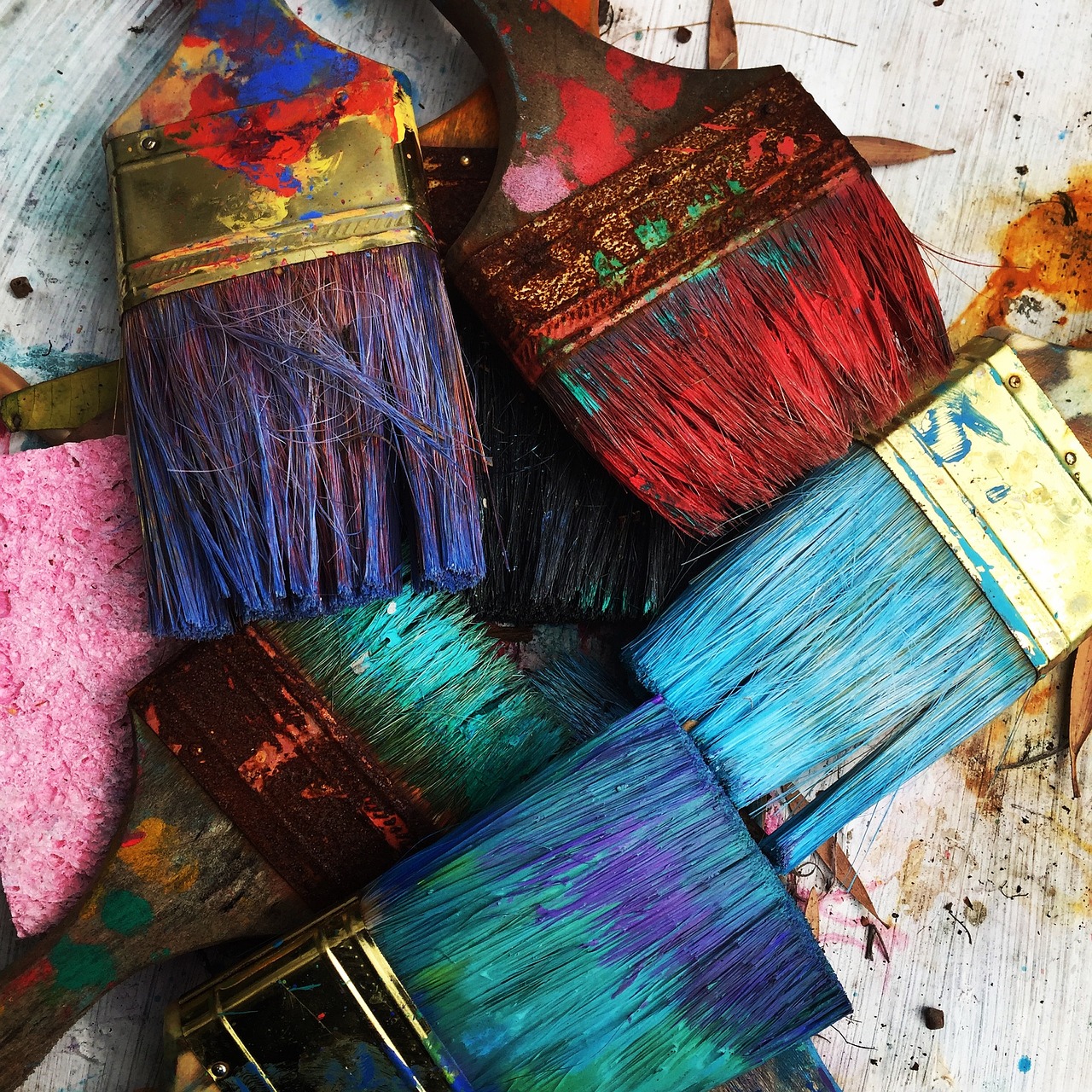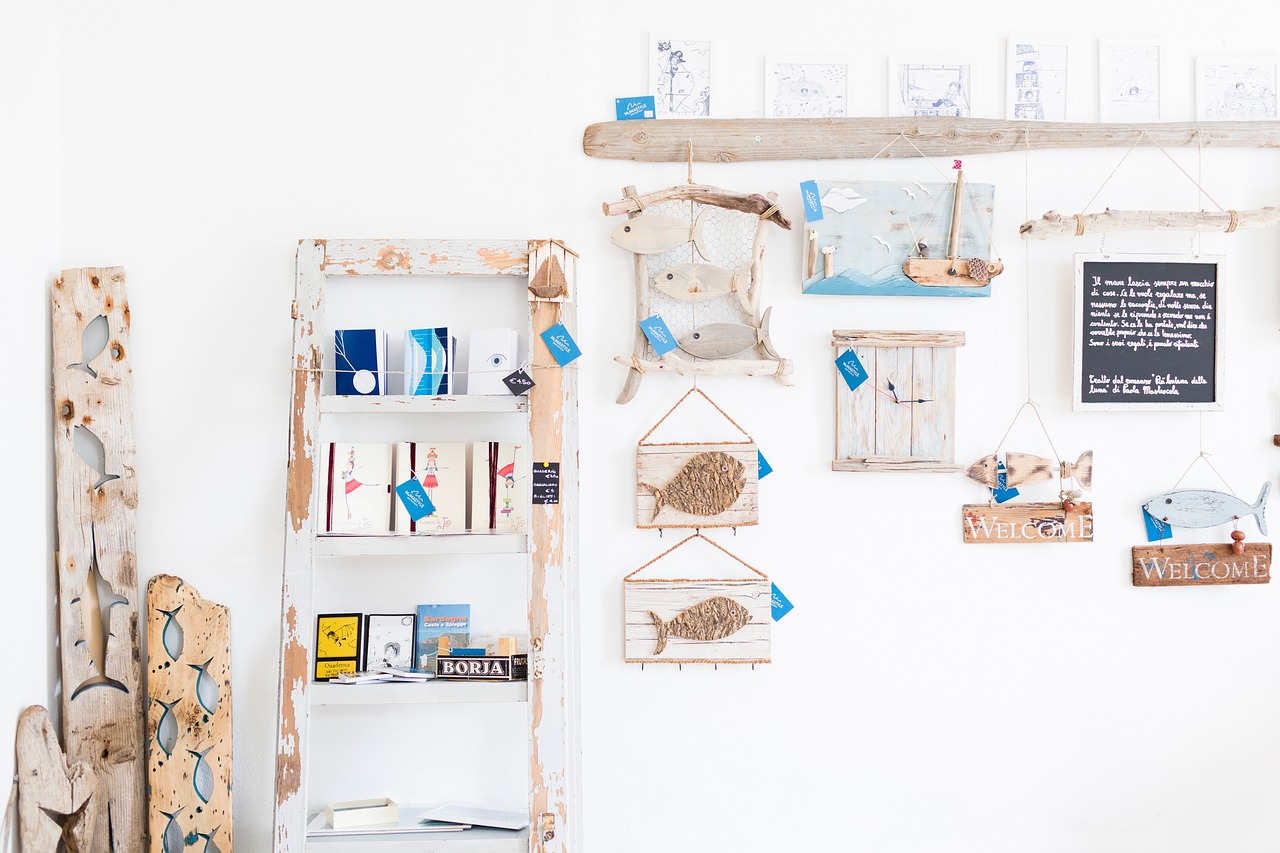Tips for Creating an Eye-Catching Art Display
Creating an art display that truly captivates viewers is both an art and a science. It's not just about hanging a few pieces on the wall; it’s about crafting a visual narrative that resonates with your audience. Imagine stepping into a room adorned with vibrant colors and intriguing textures that draw you in, making you want to linger just a little longer. This article explores essential strategies for designing an engaging art display that captivates viewers and enhances the overall aesthetic of your space. Discover tips and techniques to elevate your art presentation and transform your environment into a gallery of inspiration.
Before diving into the world of art, it's crucial to evaluate your space. Every room has its own personality—some are bright and airy, while others might feel cozy and intimate. Consider the dimensions of the room, the natural lighting, and how the existing decor interacts with potential artwork. For instance, a large canvas can dominate a small space, making it feel cramped, while a collection of smaller pieces might get lost in a vast room. The goal is to ensure that your artwork complements the environment rather than competes with it. Think of your space as a stage, and the artwork as the stars of the show. How can you arrange them to create the best performance?
Selecting the right pieces is vital for an eye-catching display. When choosing artwork, consider the theme, color palette, and emotional impact of each piece. A cohesive visual narrative can be created by harmonizing these elements. For example, if your room features a calming blue color scheme, incorporating artwork with similar hues can evoke a sense of tranquility. On the other hand, introducing a bold, contrasting piece can serve as a conversation starter, adding excitement and depth to the display. Remember, the artwork should speak to you and your guests, creating an emotional connection that enriches the viewing experience.
One of the most exciting aspects of curating an art display is the opportunity to mix different art styles. Combining various styles can create a dynamic and engaging visual experience. Think of it like a well-composed symphony; the contrasting notes work together to create something beautiful. For instance, pairing a contemporary abstract piece with a classic portrait can provoke thought and spark conversation among viewers. This unexpected juxtaposition can enhance interest and intrigue, making your display more memorable. So, don’t be afraid to experiment—sometimes the most surprising combinations yield the most stunning results!
Color and texture are fundamental aspects of art displays that can dramatically influence the overall aesthetic. Balancing these elements is essential for creating visual harmony. Consider using a mix of smooth and rough textures, or vibrant and muted colors, to draw attention to your chosen pieces. For example, a sleek, glossy painting can create a striking contrast against a textured canvas. This interplay can guide the viewer's eye and create a sense of movement within the display. Just like a well-prepared meal, the right balance of flavors can elevate the entire experience!
Establishing focal points within your display is crucial for directing viewers' attention. A well-placed piece can serve as the anchor of your arrangement, drawing the eye and creating intrigue. Techniques such as using contrasting colors, unique framing, or strategic lighting can help emphasize key pieces. Think of it as spotlighting a star performer on stage; you want them to shine and capture the audience's attention. By highlighting focal points, you not only create visual interest but also guide the viewer's journey through your art display.
The arrangement of your artwork can have a profound impact on the overall effect of the display. Consider various layout options and how they affect visual flow and viewer engagement. A grid layout can provide a sense of order, while a more organic arrangement can evoke a feeling of spontaneity. When arranging your pieces, think about the pathways that viewers will take as they explore your display. Will they feel drawn in, or will they feel lost? The goal is to create a seamless flow that invites exploration and sparks curiosity.
Proper lighting can enhance the beauty of your artwork and transform your display into a captivating experience. The right lighting can highlight textures, bring out colors, and create mood. It’s essential to consider different lighting techniques and how they can work together to create an inviting atmosphere. For instance, using soft, diffused lighting can create a warm ambiance, while brighter, focused lighting can draw attention to specific pieces. Think of lighting as the seasoning in your art display; it can elevate the entire experience when used thoughtfully!
Understanding the differences between natural and artificial lighting is essential for achieving the best results. Natural light can bring out the true colors and details of your artwork, while artificial lighting can offer more control over the ambiance. However, too much direct sunlight can fade colors over time, so it’s important to strike a balance. Consider how the time of day affects your display—does it look different in the morning compared to the evening? By observing these changes, you can adjust your lighting strategy accordingly to ensure your artwork always looks its best.
Spotlighting can create drama and focus in your art display. By using spotlights strategically, you can highlight specific pieces and enhance the overall atmosphere of the space. Imagine walking into a gallery where certain artworks are illuminated, creating a sense of importance and intrigue. This technique not only draws the viewer's eye but also adds depth to the overall presentation. Experiment with different angles and intensities to find the perfect balance for your display.
Regular maintenance is key to preserving the integrity of your art display. Keeping your artwork clean and well-cared-for ensures that it remains vibrant and appealing. Dust can accumulate over time, dulling the colors and details of your pieces. To maintain your display, consider the following best practices:
- Regularly dust frames and surfaces with a soft cloth.
- Avoid direct sunlight to prevent fading.
- Handle artwork with care, especially when cleaning.
By following these simple maintenance tips, you can keep your art display looking its best and continue to captivate viewers for years to come.
Q: How do I choose the right artwork for my space?
A: Consider the room's color palette, theme, and emotional impact of the artwork. Choose pieces that resonate with you and complement the existing decor.
Q: Can I mix different art styles?
A: Absolutely! Mixing different styles can create a dynamic and engaging display. Just ensure that the overall arrangement feels cohesive.
Q: What lighting is best for displaying art?
A: A combination of natural and artificial lighting often works best. Use soft, diffused light to create ambiance, while spotlights can highlight specific pieces.
Q: How often should I maintain my art display?
A: Regular maintenance is essential. Dust your artwork every few weeks and check for any signs of damage or fading.

Understanding Your Space
When it comes to creating an eye-catching art display, the first step is to truly understand your space. This means taking a good look at the room where you plan to showcase your artwork. Are you dealing with a cozy nook or a grand hall? The dimensions of your space will play a significant role in determining how you arrange your pieces. For instance, a small room might benefit from fewer, larger pieces that can create an impact without overwhelming the senses, while a larger area can accommodate a collection of smaller works that invite viewers to explore.
Next, consider the lighting. Natural light can bring out the vibrant colors in your art, but it can also cause glare or fading over time. On the other hand, artificial lighting can be manipulated to create the perfect ambiance. Think about how the light changes throughout the day and how it interacts with your artwork. You might even want to experiment with different lighting setups to see what makes your pieces shine the most.
Additionally, take note of your existing decor. The style, colors, and textures already present in your space should complement your artwork rather than compete with it. For example, if your room is filled with minimalist furniture, consider selecting artwork that has a similar aesthetic to maintain a cohesive look. Conversely, if your decor is more eclectic, you might want to choose bold and vibrant pieces that can stand out and become conversation starters.
To help visualize your space, consider creating a simple
| Aspect | Considerations |
|---|---|
| Dimensions | Size of the room, wall space available |
| Lighting | Natural vs. artificial, intensity, and direction |
| Existing Decor | Style, colors, and textures of furniture and walls |
By carefully evaluating these elements, you can create a harmonious art display that not only enhances your space but also captivates anyone who walks through the door. Remember, your artwork should tell a story, and understanding your space is the first chapter in that narrative. So, take your time, get creative, and let your art shine in a way that reflects your unique style!
- How do I choose the right wall for my art display? Consider the visibility and lighting of the wall. A wall that is frequently seen and well-lit is ideal for showcasing art.
- What if my space has too much clutter? Simplify your decor to allow the art to take center stage. Sometimes less is more!
- Can I mix different art styles in one display? Absolutely! Mixing styles can create a dynamic and engaging visual experience.

Choosing the Right Artwork
When it comes to creating an eye-catching art display, the selection of artwork is paramount. Choosing the right pieces is akin to selecting the perfect ingredients for a gourmet dish; each element must harmonize to create a delightful experience. Start by considering the theme of your space. Are you aiming for a modern, minimalist vibe, or do you prefer a more eclectic, bohemian feel? The artwork should resonate with the overall atmosphere you want to cultivate.
Next, think about the color palette. Colors evoke emotions and set the tone of a room. For instance, if your space is painted in soft pastels, vibrant, bold artwork might clash rather than complement. Instead, consider selecting pieces that either match or provide a striking contrast to your existing decor. This balance can create a visual dialogue that draws viewers in and keeps them engaged.
Another crucial aspect is the emotional impact of the artwork. Art is not just about aesthetics; it should tell a story or evoke a feeling. When selecting pieces, ask yourself questions like: “What emotions do I want to convey?” or “How do I want people to feel when they see this artwork?” This reflection can guide you toward pieces that resonate on a deeper level, creating a more meaningful display.
In your quest to choose the right artwork, consider mixing different styles. This can create a dynamic and intriguing display. For example, pairing a classic oil painting with modern abstract pieces can spark conversation and provoke thought. It’s like creating a symphony where each instrument plays a different note, yet together they produce a beautiful melody. Just remember, while variety is exciting, it’s essential to maintain a sense of cohesion throughout your selection.
To illustrate these points, here’s a quick table summarizing the key elements to consider when choosing artwork:
| Element | Considerations |
|---|---|
| Theme | Modern, Eclectic, Minimalist, etc. |
| Color Palette | Complementary, Contrasting, Harmonious |
| Emotional Impact | Joyful, Reflective, Provocative |
| Style | Classic, Contemporary, Abstract, etc. |
In conclusion, choosing the right artwork is a thoughtful process that requires you to consider various factors, from the theme and color palette to the emotional resonance of each piece. By taking the time to curate your selection, you’ll create an art display that not only captivates viewers but also enhances the overall aesthetic of your space. Remember, art is a reflection of you and your tastes, so let your personality shine through in your choices!
- How do I know if the artwork fits my space? Consider the size, color, and theme of both the artwork and your space to ensure they complement each other.
- Can I mix different art styles? Absolutely! Mixing styles can create a unique and dynamic display, just ensure there’s a cohesive theme.
- What should I prioritize when selecting artwork? Focus on the emotional impact and how the pieces resonate with your personal aesthetic.

Mixing Different Art Styles
When it comes to creating an eye-catching art display, one of the most exciting and effective strategies is . Imagine walking into a room where traditional paintings hang alongside modern sculptures, or where abstract pieces coexist with realistic portraits. This eclectic approach not only adds depth to your display but also invites viewers to engage with the art on multiple levels. The beauty of mixing styles lies in the contrast; it can provoke thought, spark conversation, and create a dynamic visual experience that keeps people coming back for more.
To successfully blend different art styles, you need to consider how they interact with one another. For instance, placing a sleek, contemporary piece next to a rustic, vintage artwork can create a stunning juxtaposition that highlights the uniqueness of each style. Here are some tips to keep in mind:
- Find Common Ground: Look for shared elements, such as color, theme, or texture, which can create a sense of unity among diverse pieces.
- Play with Scale: Mixing large and small artworks can add visual interest and keep the viewer's eye moving throughout the display.
- Consider the Narrative: Think about the story you want to tell. Different styles can represent various chapters of your narrative, creating a richer experience.
Moreover, don't shy away from using unexpected combinations. A bold abstract painting might play beautifully against a delicate watercolor, or a striking modern sculpture could stand out against a backdrop of classical art. The key is to experiment and see what resonates with you. Just like in fashion, where mixing patterns and styles can lead to stunning results, the same principle applies to art. Remember, art is subjective, and what may seem like an odd pairing to one person could be a masterpiece to another.
Additionally, consider the emotional impact of the pieces you choose. Different art styles evoke various feelings and thoughts. For example, a serene landscape painting can bring a sense of calm, while a vibrant pop art piece may energize the space. By thoughtfully combining these emotional responses, you create a multi-layered experience that engages viewers in a profound way.
In conclusion, mixing different art styles can transform a simple display into a vibrant conversation starter. Embrace the unexpected, trust your instincts, and let your creativity shine. After all, art is about expression, and what better way to express yourself than through a diverse and captivating collection that reflects your unique taste?
Q: Can I mix any art styles together?
A: Yes! The beauty of art is its subjectivity. Feel free to experiment with various styles, but look for common themes or colors to create cohesion.
Q: How do I know if my mixed display is working?
A: Trust your instincts! If you find the arrangement visually appealing and it resonates with you, it’s likely to engage others as well. You can also ask friends or family for their input.
Q: Should I stick to a specific color palette when mixing styles?
A: While it's not strictly necessary, using a cohesive color palette can help unify different styles and create a harmonious display.

Balancing Color and Texture
When it comes to creating an eye-catching art display, is like orchestrating a symphony. Each element plays its part, and when they harmonize, the result is nothing short of mesmerizing. Imagine walking into a room where vibrant colors clash chaotically, or where textures feel disjointed and uninviting. Not quite the experience you want, right? Instead, think of how a well-balanced display can evoke emotions and draw viewers in, much like a captivating story.
To achieve this balance, start by considering the color palette of your artwork. Are you working with bold, vibrant hues, or softer, muted tones? The key is to create a cohesive look that feels intentional rather than random. For example, if you have a striking red painting, consider pairing it with complementary colors like soft greens or blues in other pieces. This not only creates visual interest but also prevents any one piece from overwhelming the others.
Next, let’s talk about texture. Texture adds depth to your display and can completely change the way colors are perceived. A smooth canvas can feel stark next to a rough, textured sculpture. To create a balanced display, think about incorporating a variety of textures. You might mix sleek paintings with rustic wood frames, or combine glossy ceramics with soft textiles. This interplay invites viewers to engage with the display on multiple levels.
Here’s a quick tip: consider creating a color and texture chart to visualize your display. This can help you see how different pieces interact with one another. For instance, you could have a table like this:
| Artwork | Color | Texture |
|---|---|---|
| Abstract Painting | Vibrant Red | Smooth |
| Wooden Sculpture | Natural Brown | Rough |
| Textile Wall Hanging | Soft Blue | Soft |
This chart helps you visualize the relationships between color and texture, ensuring that your display feels balanced. Remember, the goal is to create a dialogue between the pieces, where colors complement and textures contrast in a way that feels harmonious.
In conclusion, achieving a balance between color and texture is essential for an engaging art display. By thoughtfully selecting your artwork and considering how each piece interacts with others, you can create a stunning visual narrative that captivates and enchants all who enter the space. So, the next time you curate an art display, think about how you can weave together color and texture to create a truly immersive experience.
- How can I choose a color palette for my art display? Consider the emotions you want to evoke and select colors that complement each other.
- What types of textures work well together? Mixing smooth, rough, soft, and glossy textures can create visual interest.
- Should I focus more on color or texture? Both are important; aim for a balance that enhances the overall aesthetic of your display.

Highlighting Focal Points
When it comes to creating an engaging art display, is like setting the stage for a captivating performance. Just as a spotlight draws your attention to a leading actor, establishing focal points within your artwork directs viewers’ eyes to the pieces you want to showcase. This technique not only enhances the aesthetic appeal of your display but also creates a narrative that guides the viewer through the space.
To effectively highlight focal points, consider the following strategies:
- Choose Key Pieces: Identify the artwork that resonates most with you or that you want to emphasize. This could be a vibrant painting, a striking sculpture, or even a unique installation. The key is to select pieces that stand out and evoke emotion.
- Utilize Space Wisely: Give your focal points room to breathe. Avoid overcrowding them with too many other pieces. This allows each focal point to shine and makes it easier for viewers to appreciate the details.
- Frame Your Art: Consider using frames or borders to draw attention to your focal points. A well-chosen frame can enhance the artwork's beauty and create a visual separation from other pieces.
- Incorporate Contrasting Elements: Placing contrasting colors, styles, or textures around your focal points can make them pop even more. For instance, a bright abstract painting can be perfectly complemented by the soft, muted tones of surrounding pieces.
Another effective method for emphasizing focal points is through the use of lighting techniques. Just as a director uses lighting to enhance a scene, you can use various lighting options to create drama and focus. Consider using spotlights to illuminate your key pieces, casting them in a flattering light that highlights their unique characteristics. This not only draws attention but also adds depth and dimension to your display.
Furthermore, think about the flow of your display. Arrange your artwork in a way that naturally guides the viewer's gaze from one focal point to another. This can be achieved through strategic placement and the use of leading lines, which can be found in the artwork itself or in the arrangement of the pieces. By creating a visual journey, you engage viewers and encourage them to explore your display more thoroughly.
In conclusion, highlighting focal points is an essential strategy for creating an eye-catching art display. By selecting key pieces, utilizing space wisely, incorporating contrasting elements, and employing effective lighting techniques, you can create a captivating experience that invites viewers to not only look but truly see the art. Remember, every piece has a story to tell, and your job is to make sure those stories are heard loud and clear!
Q: How do I choose the right focal points for my art display?
A: Look for artwork that resonates with you emotionally or has significant visual impact. Consider the size, color, and subject matter to ensure they stand out in your display.
Q: Can I have multiple focal points in one display?
A: Absolutely! Just ensure that they are well spaced and that the arrangement allows for a natural flow of attention from one piece to another.
Q: How can lighting enhance my focal points?
A: Proper lighting can dramatically change the perception of your artwork. Use spotlights or directional lighting to highlight key pieces, creating depth and drawing the viewer’s eye.

Arranging Artwork Strategically
When it comes to creating an art display that truly captivates, the arrangement of your artwork is nothing short of crucial. Imagine walking into a gallery where every piece is perfectly positioned to draw your eye, creating a flow that feels both natural and engaging. This is the magic of strategic arrangement. It’s not just about slapping some art on the wall; it’s about crafting a visual journey that guides viewers through your collection. So, how do you achieve this? Let’s dive into some effective strategies!
First off, consider the scale and proportion of the artworks in relation to the space. A large painting can dominate a small wall, whereas smaller pieces might get lost in a vast expanse. The key is to create a balance that feels harmonious. For instance, if you have a large canvas, pair it with smaller artworks to create a layered look. This not only enhances the visual interest but also allows viewers to appreciate the details in each piece without feeling overwhelmed.
Next, think about the visual flow. This is all about how your eyes move across the display. To facilitate a smooth flow, you might want to arrange your pieces in a way that leads the viewer's gaze from one artwork to the next. For example, you could create a zigzag pattern or a linear arrangement. The goal is to avoid a chaotic feel; instead, aim for a cohesive narrative that tells a story as people move through the space.
Another effective technique is to use thematic groupings. This involves clustering artworks that share a common theme or color palette. Not only does this enhance the overall aesthetic, but it also encourages viewers to engage more deeply with the pieces. For instance, if you have a series of landscapes, displaying them together can evoke a sense of tranquility and connection to nature. On the other hand, contrasting themes can spark conversation and provoke thought, so don’t shy away from mixing it up!
Finally, consider the height at which you hang your artwork. A common rule of thumb is to position the center of the artwork at eye level, typically around 57 to 60 inches from the floor. However, this can vary based on the height of your walls and the average height of your guests. If you’re displaying a series of artworks, try to keep them at a consistent height to maintain visual coherence. If you have children or pets, you might even want to hang some pieces lower to allow them to appreciate the art as well!
In summary, arranging artwork strategically is about creating a visual dialogue that resonates with viewers. By considering scale, visual flow, thematic groupings, and proper height, you can transform any wall into a captivating art display that invites exploration and admiration.
- What is the best way to determine the height for hanging artwork? Aim for the center of the artwork to be around 57 to 60 inches from the floor, adjusting based on the height of your walls and average viewer height.
- How can I create a cohesive theme in my art display? Group artworks by theme or color palette to create a visual narrative that enhances the overall aesthetic.
- Is it better to mix different art styles or stick to one? Mixing different styles can create a dynamic and engaging display, but ensure there’s a common thread, like color or theme, to tie them together.
- How do I maintain the balance in my art display? Balance can be achieved by considering the scale of each piece and arranging them in a way that feels harmonious, avoiding overcrowding or isolation of any artwork.

Lighting Techniques for Art Displays
When it comes to creating an engaging art display, lighting is often the unsung hero. It's like the icing on the cake; without it, your artwork might just blend into the background. Proper lighting not only enhances the beauty of your pieces but also sets the mood and atmosphere of the entire space. Have you ever walked into a gallery and felt instantly captivated by how the artwork seemed to glow? That’s the magic of effective lighting at work!
There are several techniques you can employ to ensure your art shines in the best light—literally! Here are some key methods to consider:
- Ambient Lighting: This is the general illumination of the room. Think of it as the foundation of your lighting scheme. Soft, diffused light can create a warm atmosphere and make your space feel inviting.
- Task Lighting: If you have specific areas where you want to draw attention, task lighting is your best friend. This could be a spotlight or a lamp that focuses directly on a piece of art, highlighting its details and colors.
- Accent Lighting: Want to make a statement? Accent lighting can be used to emphasize certain pieces, creating a dramatic effect. This can be achieved with track lighting or wall-mounted fixtures.
Now, let’s dive deeper into the two main types of lighting: natural and artificial. Each has its own unique characteristics and can dramatically affect the perception of your artwork.
Natural lighting is often considered the gold standard when it comes to illuminating art. It brings out the true colors and textures of the artwork, making it look vibrant and alive. However, it's essential to control this light. Too much direct sunlight can fade colors over time, so using sheer curtains or blinds can help diffuse the light while still allowing it to pour in. Imagine a painting bathed in soft, golden sunlight—it's a sight to behold!
On the other hand, artificial lighting offers flexibility. You can adjust the intensity and direction to create the perfect ambiance. However, be cautious with the type of bulbs you choose. Incandescent bulbs provide a warm glow, while LED lights are energy-efficient and can be adjusted to emit different colors. The key is to avoid harsh lighting that can create unflattering shadows or distort the colors of your artwork.
Spotlighting can be a game-changer for your art display. By directing light onto specific pieces, you can create a focal point that draws viewers in. Think of it as a theatrical performance where each piece of art takes center stage. To achieve this, consider the following:
1. Position spotlights at a 30-degree angle to avoid glare. 2. Use dimmable lights to adjust the intensity based on the time of day. 3. Experiment with different placements to see what works best for each piece.
Incorporating these lighting techniques can transform your art display from ordinary to extraordinary. Remember, the goal is to create a harmonious blend of light and art that captivates your audience and enhances their viewing experience. So, think of lighting not just as a necessity, but as an integral part of your artistic expression!
Q: What type of lighting is best for my art display?
A: The best type of lighting depends on your artwork and the atmosphere you want to create. A combination of natural and artificial lighting, tailored to your specific pieces, often works best.
Q: How can I prevent my artwork from fading due to sunlight?
A: Use UV-filtering glass or acrylic for framing and consider using sheer curtains to diffuse direct sunlight.
Q: Is it necessary to use spotlights?
A: While not necessary, spotlights can enhance certain pieces and create a dramatic effect, making them a worthwhile addition to your display.

Natural vs. Artificial Lighting
When it comes to displaying art, lighting is not just an afterthought; it's a crucial element that can make or break the overall impact of your artwork. Understanding the difference between natural and artificial lighting is essential for creating an inviting and visually stunning art display. Imagine walking into a gallery where the sunlight streams through large windows, casting a warm glow on the paintings. That’s the magic of natural lighting! It has the ability to enhance colors and bring out details that might otherwise be overlooked. However, natural light can be unpredictable, changing throughout the day and varying with the seasons.
On the flip side, artificial lighting offers a level of control that natural light simply can't match. You can adjust the intensity, direction, and color temperature to suit your specific needs. Think of it like having a dimmer switch for your mood—artificial lighting can create a cozy, intimate atmosphere or a bright, energizing space depending on your preferences. But beware! Not all artificial lights are created equal. For instance, fluorescent lights can wash out colors, while LED lights can enhance vibrancy when chosen wisely.
To help you decide which lighting is best for your art display, consider the following comparison:
| Aspect | Natural Lighting | Artificial Lighting |
|---|---|---|
| Color Accuracy | High | Varies (can be adjusted) |
| Control | Low (depends on time of day) | High (can be manipulated) |
| Atmosphere | Warm and inviting | Can vary from cozy to clinical |
| Cost | Free (but depends on building design) | Varies (installation and electricity costs) |
Ultimately, the best approach is often a combination of both natural and artificial lighting. Use natural light during the day to create a vibrant atmosphere, and then switch to artificial lighting in the evening to maintain the visual impact of your display. This way, you can enjoy the best of both worlds, ensuring that your artwork is always showcased in the most flattering light.
In conclusion, whether you lean towards the organic feel of sunlight or the versatility of artificial sources, understanding the strengths and weaknesses of each type of lighting will empower you to create an art display that captivates and enchants your audience.
- What type of lighting is best for paintings? Generally, a combination of natural and artificial lighting works best. Natural light enhances colors, while artificial light provides control.
- How can I prevent glare on my artwork? Position your lights at an angle and use diffusers to soften the light, reducing glare and reflections.
- Should I use LED or incandescent bulbs? LED bulbs are often better for art displays as they produce less heat and have a longer lifespan, but choose bulbs with a high Color Rendering Index (CRI) for the best color accuracy.

Using Spotlighting Effectively
When it comes to creating an unforgettable art display, spotlighting can be a game changer. Imagine walking into a room where a stunning piece of art immediately catches your eye, drawing you in like a moth to a flame. That's the magic of effective spotlighting! It's not just about illuminating your artwork; it's about crafting a mood, enhancing details, and creating an atmosphere that resonates with viewers.
To harness the full potential of spotlighting, you need to consider a few key elements. First, think about the angle of your lights. A well-placed spotlight can highlight textures and colors in a way that flat lighting simply cannot. For instance, if you have a textured piece, such as a painting with thick brush strokes or a sculpture with intricate details, positioning your spotlight at a slight angle can create shadows that add depth and intrigue. This technique not only enhances the visual appeal but also invites viewers to explore the artwork more closely.
Next, let’s talk about intensity. The brightness of your spotlight can dramatically influence the viewer's experience. Too bright, and you risk washing out the colors; too dim, and the artwork may fade into the background. A good rule of thumb is to aim for a balance where the artwork is well-lit but still retains its natural hues. Experimenting with different wattages or types of bulbs can help you find that sweet spot. For example, LED lights are often favored for their brightness and energy efficiency, while halogen lights can provide a warm glow that enhances the richness of colors.
Another essential aspect of spotlighting is layering light. This involves using multiple light sources to create a more dynamic and engaging display. By combining spotlights with ambient lighting, you can create a sense of depth and dimension. Think of it like painting a landscape; the foreground needs to be illuminated while the background should softly fade, drawing the viewer's eye through the entire composition. This layered approach not only highlights individual pieces but also enhances the overall atmosphere of the space.
Lastly, don’t forget to consider the color temperature of your lights. The warmth or coolness of the light can change the perception of your artwork. Warmer lights (around 2700K to 3000K) can make colors appear richer and more inviting, while cooler lights (around 4000K to 5000K) can create a more modern and crisp look. Depending on the mood you want to evoke, choose your light temperature wisely. It’s like dressing your artwork in the perfect outfit for a special occasion!
In summary, using spotlighting effectively is about more than just illuminating your art; it’s about creating a visual narrative that captivates and engages your audience. By paying attention to the angle, intensity, layering, and color temperature of your lights, you can transform your art display into a breathtaking experience that resonates with everyone who walks through the door.
- What type of spotlight is best for art displays? LED spotlights are often recommended due to their brightness and energy efficiency, but halogen lights can also provide a warm glow.
- How can I create depth in my art display? Layering different types of lighting, such as combining spotlights with ambient light, can help create depth and dimension.
- What is the ideal angle for spotlighting artwork? A slight angle is recommended to highlight textures and create shadows, enhancing the visual appeal of the artwork.
- Does the color temperature of lighting matter? Yes, the color temperature can significantly affect how colors in the artwork are perceived, so choose accordingly based on the mood you want to create.

Maintaining Your Art Display
Maintaining your art display is not just about keeping things tidy; it's about preserving the essence and beauty of each piece. Just like a garden needs care to flourish, your artwork requires attention to ensure it continues to inspire and captivate. Regular maintenance can significantly extend the life of your art, preventing damage from dust, light, and environmental factors. So, how do you keep your art looking its best? Let’s dive into some essential practices.
First and foremost, cleaning your artwork is crucial. Dust can accumulate over time, dulling the vibrancy of colors and textures. Use a soft, dry cloth to gently wipe surfaces, and for framed pieces, consider using a microfiber cloth to avoid scratching the glass. If you have more delicate works, like paintings on canvas, it’s wise to consult with a professional conservator to avoid damaging the piece. Remember, a little care can go a long way in preserving your investment.
Next, consider the environment where your art is displayed. Factors such as humidity, temperature, and light can all affect your artwork. For instance, paintings should ideally be kept in a climate-controlled room to prevent warping or fading. If your art is exposed to sunlight, think about using UV-filtering glass or placing it in a location that minimizes direct sunlight. This not only protects the artwork but also enhances its longevity.
Moreover, it’s essential to rotate your collection periodically. Just like a wardrobe, your art can benefit from a change of scenery. Rotating pieces not only keeps your display fresh but also gives each work a chance to shine in a new light. This can be particularly effective for seasonal displays or thematic exhibitions where certain pieces might resonate more at different times of the year.
Lastly, keeping a detailed inventory of your art collection is a smart move. Document each piece, including its condition, any maintenance performed, and its history. This not only helps you track your collection but also assists in managing insurance and valuation if needed. A simple table can be a great way to organize this information:
| Artwork Title | Artist | Condition | Last Maintenance Date | Notes |
|---|---|---|---|---|
| Starry Night | Vincent van Gogh | Excellent | 01/01/2023 | Minor dusting |
| The Scream | Edvard Munch | Good | 12/15/2022 | Check for fading |
By following these maintenance tips, you can ensure that your art display remains a source of joy and inspiration for years to come. Remember, a well-maintained display not only enhances the aesthetic of your space but also reflects your appreciation for the artistry and effort behind each piece.
Q: How often should I clean my artwork?
A: It’s recommended to clean your artwork every few months, or more frequently if you notice dust accumulating.
Q: Can I use water to clean my paintings?
A: No, avoid using water on paintings, especially those on canvas. Instead, use a dry cloth or consult a professional for cleaning advice.
Q: How can I protect my artwork from sunlight?
A: Use UV-filtering glass or place your artwork in areas that receive minimal direct sunlight to prevent fading.
Q: What should I do if I notice damage to my artwork?
A: If you see any damage, it's best to consult a professional conservator who can assess and advise on the best course of action.
Frequently Asked Questions
- How do I choose the right artwork for my space?
Choosing the right artwork is all about understanding your personal style and the vibe of your space. Think about the theme you want to convey and consider the color palette of your room. It’s like dressing up for a party; you want your artwork to complement the mood and enhance the overall aesthetic!
- What are some tips for arranging my artwork?
Arranging artwork can feel like putting together a puzzle. Start by laying out your pieces on the floor to see how they fit together. Consider creating a focal point with a standout piece, then arrange other pieces around it for balance. Remember, it’s all about creating a flow that guides the viewer’s eye!
- How important is lighting in an art display?
Lighting is crucial! It’s like the spotlight on a stage; it can make or break the performance. Proper lighting can enhance colors and textures, making your artwork pop. Consider using natural light during the day and spotlights for evening displays to create a warm and inviting atmosphere.
- Can I mix different art styles in one display?
Absolutely! Mixing different art styles can create a dynamic and engaging display. Think of it as a beautiful conversation between contrasting pieces. Just ensure there’s a common thread, like a shared color palette or theme, to keep everything cohesive.
- What should I do to maintain my art display?
Regular maintenance is key to keeping your art looking fresh. Dust your pieces gently and avoid direct sunlight, which can fade colors over time. It’s like taking care of a garden; with a little love and attention, your artwork will thrive!



















